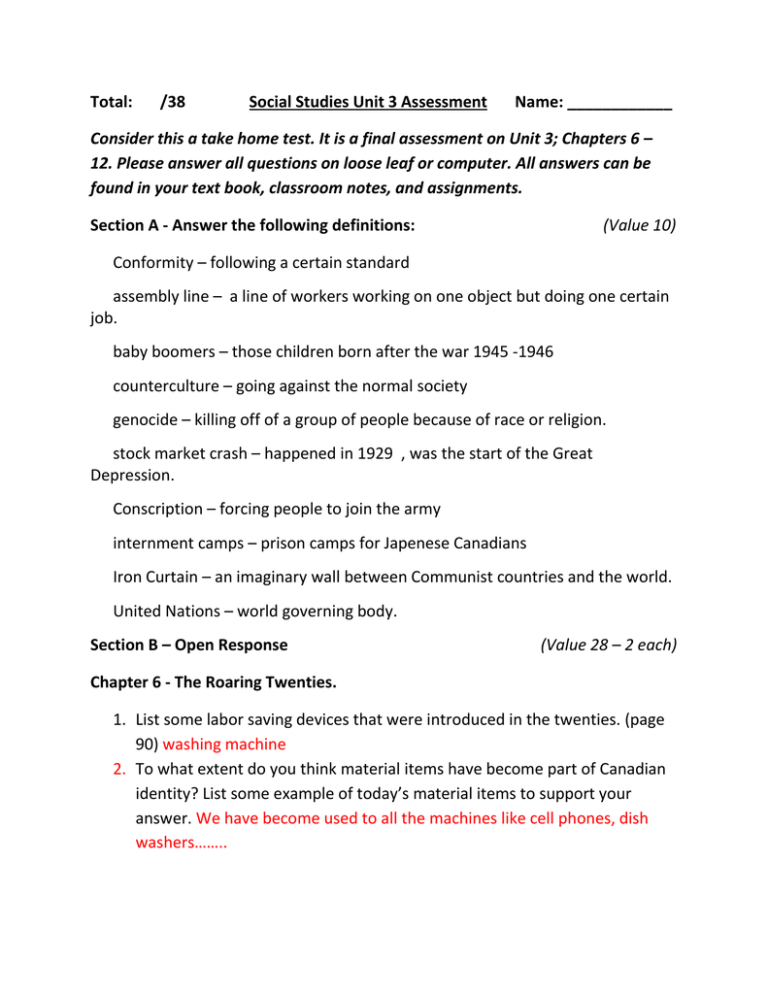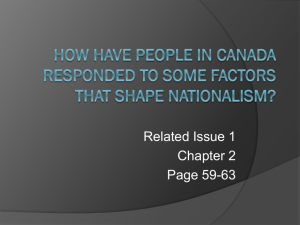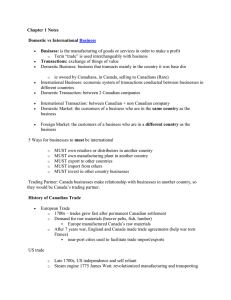unit_3_assessment_with_answers_2015
advertisement

Total: /38 Social Studies Unit 3 Assessment Name: ____________ Consider this a take home test. It is a final assessment on Unit 3; Chapters 6 – 12. Please answer all questions on loose leaf or computer. All answers can be found in your text book, classroom notes, and assignments. Section A - Answer the following definitions: (Value 10) Conformity – following a certain standard assembly line – a line of workers working on one object but doing one certain job. baby boomers – those children born after the war 1945 -1946 counterculture – going against the normal society genocide – killing off of a group of people because of race or religion. stock market crash – happened in 1929 , was the start of the Great Depression. Conscription – forcing people to join the army internment camps – prison camps for Japenese Canadians Iron Curtain – an imaginary wall between Communist countries and the world. United Nations – world governing body. Section B – Open Response (Value 28 – 2 each) Chapter 6 - The Roaring Twenties. 1. List some labor saving devices that were introduced in the twenties. (page 90) washing machine 2. To what extent do you think material items have become part of Canadian identity? List some example of today’s material items to support your answer. We have become used to all the machines like cell phones, dish washers…….. Chapter 7 - Canada at War 1. Read the information on Sergeant Tommy Prince (page 112) who fought for Canada even though Canada discriminated against First Nations. What conclusions do you draw? How did Sergeant Tommy Prince’s actions affect the thoughts of people in the future? First Nations man joined the army. Was a hero. He changed people’s opinions about natives. 2. What does that reveal about Canada’s sense of identity at that time? At the time a lot of Canadians were prejudice. Chapter 8 - WW2: The Home Front 1. Why did the government not want to accept Canada’s racial and ethnic minorities into the military? Prejudice. 2. Why did the government change its mind about accepting minorities into the military as the war progressed? Tommy Prince’s actions changed many people’s view point. Chapter 9 – Canada in the World: Cold War 1. How did the increasing role that Canada played in the world after the Second World War affect Canada’s identity? We were seen as an important nation in the world. 2. What does the statement “Canada is a middle power” mean? (Page 146) We are important but not a super power like the USA. 3. Explain why the NORAD agreement was so controversial? The Radar system not only interfere with the environment and Inuit culture it challenge the Canadian Identity and independence because the USA technology on Canadian soil was receiving its orders from the United States. Chapter 10 – Post War Technology 1. Describe one change in technology that took place during the 1950s. Your answer should include a description of that technology, and how it changed the average Canadian’s life. TV changed the way we entertain ourselves. 2. What was the first Canadian television station? CBC 3. Name a Canadian infrastructure project of the 1950,s and explain how it affects Canadian lifestyles? The St. Lawrence Seaway allowed transporting goods and products cheaper and easily. The Canso causeway linked Cape Breton Island with the mainland The Toronto Subway allowed for people of the city move around better without traffic jams. The MacKay bridge connected Dartmouth and Halifax so people did not have to travel around the Bedford Basin. Chapter 11 – Changing Times 1. Describe one movement of the 1960s. Your response should include what the movement stood for, and important people within the movement. Civil rights movements changed many Canadian’s thinking.- Viola Desmond Multiculturalism – it became law under the multicultural act to respect all cultures Women’s rights movement established maternity benefits, equal pay for equal work and no discrimination on the basis of gender. 2. “Bell bottoms” were a fashion trend that began in what decade? 1960s 3. What was the Cold War and describe the fear and mistrust between the 2 super powers that existed at this time. The Cold War was a friction between 2 super powers (USA & the USSR). Each did not trust that the other would not attack with nuclear weapons. 4. The catalyst for change in the 1960s was the contrasting idealism of the 60s with the reality of the events that were occurring during the 1960s. Explain this statement. The idealism of peace and love was in direct contrast with the war in Vietnam and the fierce actions of the government towards the Civil rights protests. Chapter 12 – Globalization 1. What is globalization? The spread of a company throughout the world. 2. Name one company that is “globalized”. McDonalds. 3. List one positive and one negative effect of globalization on Canadians. Cheaper products for consumers, work for the poor in 3rd world countries 3rd world countries may have relaxed safety laws and environmental laws 4. How did globalization help to bring an end to the Cold War? Mikhail Gorbachev becomes leader in 1985. USSR in economic difficulty. he changes the economic and political systems. This may well be due to the global influence of capitalism. He introduces capitalist elements into his country Relationship between USSR (Russia) and USA are on friendlier terms so the Russians felt less pressure to keep up with the arms race. The United States and Russia sign an agreement to reduce the nuclear weapons. Many satellite countries of the Soviet Union reject communism and break away from the Soviet Union. The Berlin Wall comes down - 1989 U.S.A stands alone as a superpower. The cold war ends




